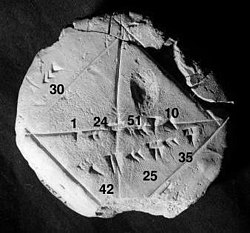Sexagesimal
Sexagesimal (base 60) is a number system with sixty as its base. It was invented by the ancient Sumerians in the 3rd millennium BC.[1] It was passed down to the ancient Babylonians, and it is still used—in a modified form—for measuring time, angles, and geographic coordinates.
The number 60 is a composite number. It has twelve factors, namely 1, 2, 3, 4, 5, 6, 10, 12, 15, 20, 30, and 60, of which 2, 3, and 5 are prime numbers.
Therefore, using sexagesimal numbers, fractions are simplified. For example, one hour can be divided evenly into sections of 30 minutes, 20 minutes, 15 minutes, 12 minutes, 10 minutes, 6 minutes, 5 minutes, 4 minutes, 3 minutes, 2 minutes, and 1 minute.
60 is the smallest number that is divisible by every number from 1 to 6; that is, it is the lowest common multiple of 1, 2, 3, 4, 5, and 6.
Note: here in this article, all sexagesimal digits are represented as decimal numbers. For example, 10 means the number ten and 60 means the number sixty.[2]


